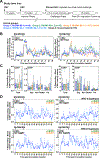Cytomegaloviral determinants of CD8+ T cell programming and RhCMV/SIV vaccine efficacy
- PMID: 33766849
- PMCID: PMC8244349
- DOI: 10.1126/sciimmunol.abg5413
Cytomegaloviral determinants of CD8+ T cell programming and RhCMV/SIV vaccine efficacy
Abstract
Simian immunodeficiency virus (SIV) insert-expressing, 68-1 rhesus cytomegalovirus (RhCMV/SIV) vectors elicit major histocompatibility complex E (MHC-E)- and MHC-II-restricted, SIV-specific CD8+ T cell responses, but the basis of these unconventional responses and their contribution to demonstrated vaccine efficacy against SIV challenge in the rhesus monkeys (RMs) have not been characterized. We show that these unconventional responses resulted from a chance genetic rearrangement in 68-1 RhCMV that abrogated the function of eight distinct immunomodulatory gene products encoded in two RhCMV genomic regions (Rh157.5/Rh157.4 and Rh158-161), revealing three patterns of unconventional response inhibition. Differential repair of these genes with either RhCMV-derived or orthologous human CMV (HCMV)-derived sequences (UL128/UL130; UL146/UL147) leads to either of two distinct CD8+ T cell response types-MHC-Ia-restricted only or a mix of MHC-II- and MHC-Ia-restricted CD8+ T cells. Response magnitude and functional differentiation are similar to RhCMV 68-1, but neither alternative response type mediated protection against SIV challenge. These findings implicate MHC-E-restricted CD8+ T cell responses as mediators of anti-SIV efficacy and indicate that translation of RhCMV/SIV vector efficacy to humans will likely require deletion of all genes that inhibit these responses from the HCMV/HIV vector.
Copyright © 2021 The Authors, some rights reserved; exclusive licensee American Association for the Advancement of Science. No claim to original U.S. Government Works.
Conflict of interest statement
Figures








Comment in
-
CMV, MHC-E, and the quest for an unconventional AIDS vaccine.Sci Immunol. 2021 May 14;6(59):eabi5830. doi: 10.1126/sciimmunol.abi5830. Sci Immunol. 2021. PMID: 33990380
Similar articles
-
Myeloid cell tropism enables MHC-E-restricted CD8+ T cell priming and vaccine efficacy by the RhCMV/SIV vaccine.Sci Immunol. 2022 Jun 24;7(72):eabn9301. doi: 10.1126/sciimmunol.abn9301. Epub 2022 Jun 17. Sci Immunol. 2022. PMID: 35714200 Free PMC article.
-
Glycoprotein L-deleted single-cycle rhesus cytomegalovirus vectors elicit MHC-E-restricted CD8+ T cells that protect against SIV.J Immunol. 2025 Aug 1;214(8):1969-1981. doi: 10.1093/jimmun/vkaf104. J Immunol. 2025. PMID: 40420384 Free PMC article.
-
Profound early control of highly pathogenic SIV by an effector memory T-cell vaccine.Nature. 2011 May 26;473(7348):523-7. doi: 10.1038/nature10003. Epub 2011 May 11. Nature. 2011. PMID: 21562493 Free PMC article.
-
Programming cytomegalovirus as an HIV vaccine.Trends Immunol. 2023 Apr;44(4):287-304. doi: 10.1016/j.it.2023.02.001. Epub 2023 Mar 7. Trends Immunol. 2023. PMID: 36894436 Free PMC article. Review.
-
Cytotoxic T lymphocytes specific for the simian immunodeficiency virus.Immunol Rev. 1999 Aug;170:127-34. doi: 10.1111/j.1600-065x.1999.tb01334.x. Immunol Rev. 1999. PMID: 10566147 Review.
Cited by
-
Exploring synergies between B- and T-cell vaccine approaches to optimize immune responses against HIV-workshop report.NPJ Vaccines. 2024 Feb 21;9(1):39. doi: 10.1038/s41541-024-00818-y. NPJ Vaccines. 2024. PMID: 38383616 Free PMC article.
-
Immunoevasion strategies for African swine fever virus: Modulation of antigen presentation pathways.Virulence. 2025 Dec;16(1):2541711. doi: 10.1080/21505594.2025.2541711. Epub 2025 Aug 15. Virulence. 2025. PMID: 40817451 Free PMC article. Review.
-
Regulation of the cell surface expression of classical and non-classical MHC proteins by the human cytomegalovirus UL40 and rhesus cytomegalovirus Rh67 proteins.J Virol. 2024 Sep 17;98(9):e0120624. doi: 10.1128/jvi.01206-24. Epub 2024 Aug 29. J Virol. 2024. PMID: 39207137 Free PMC article.
-
Human cytomegalovirus UL18 prevents priming of MHC-E- and MHC-II-restricted CD8+ T cells.Sci Immunol. 2024 Oct 11;9(100):eadp5216. doi: 10.1126/sciimmunol.adp5216. Epub 2024 Oct 11. Sci Immunol. 2024. PMID: 39392895 Free PMC article.
-
Murine cytomegalovirus downregulates ERAAP and induces an unconventional T cell response to self.Cell Rep. 2023 Apr 25;42(4):112317. doi: 10.1016/j.celrep.2023.112317. Epub 2023 Mar 29. Cell Rep. 2023. PMID: 36995940 Free PMC article.
References
-
- Jarvis MA, Hansen SG, Nelson JA, Picker LJ, Früh K, in Cytomegaloviruses: From Molecular Pathogenesis to Intervention Reddehase MJ, Ed. (Caister Academic Press, 2013), vol. 2, chap. 21.
-
- Vieira Braga FA, Hertoghs KM, van Lier RA, van Gisbergen KP, Molecular characterization of HCMV-specific immune responses: Parallels between CD8(+) T cells, CD4(+) T cells, and NK cells. Eur J Immunol 45, 2433–2445 (2015). - PubMed
-
- Klenerman P, Oxenius A, T cell responses to cytomegalovirus. Nat Rev Immunol 16, 367–377 (2016). - PubMed
Publication types
MeSH terms
Substances
Grants and funding
LinkOut - more resources
Full Text Sources
Other Literature Sources
Medical
Research Materials

